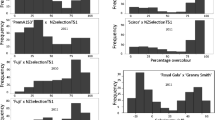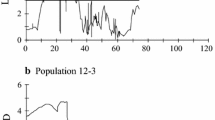Summary
This paper reviews the use of purple/green coleoptiles in wheat variety description, the identification of the anthocyanidins and anthocyanins of the purple coleoptile, its genetics and association with other characteristics.
The geographical distribution of 902 Old World local varieties or their selections with purple or green coleoptile were investigated. It appears that there is no clear distribution although in some regions only varieties with green coleoptile occur. It is possible that each of the 3 Rc loci has a special geographical distribution which has not been investigated yet.
Similar content being viewed by others
References
Anonymous, 1970. Research report of the Canada Department of Agriculture, 1968; 370 pp. See also Kerber & Dyck, 1970.
Ausemus E. R., 1934. Correlated inheritance of reaction to diseases and of certain botanical characters in triangular wheat crosses. J. agric. Res. 48: 31–57.
Ausemus E. R., 1946. A summary of genetic studies in hexaploid and tetraploid wheats. J. Am. Soc. Agron. 38: 1082–1099.
Baeva, R. & L. Mladenova, 1969. (Cytogenetic studies of wheat × rye hybrids.) Scient. Conf. Inst. Pl. Genet. Breed., (Sofia, 11–12 Dec. 1967): 23–37. Cited from Pl. Breed. Abstr. 41 (1971) No 7105.
Bragt, J. van, J. B. Brouwer & A. C. Zeven, 1967. The colour of the coleoptile of wheat. I. Anthocyanidins of the coleoptiles of some Triticinae. Wheat Inf. Serv. No 25: 2–3.
Cartarar R. 1962. Inheritance of stem rust reaction and certain other characters in a cross of Thatcher × II-53–521 and several other wheat crosses. Diss. Abstr. 1962: 23: Order No 62–3078: 405–405 (Abstr.).
Chin K.-C., 1944a. Le pigment pourpre dans le hybrides de blés européens, africains et canadiens. C.r. Acad. Sci. Paris 219: 78–80.
Chin K.-C., 1944b. Relations phylogénétiques entre le Tr. vulgare et le Tr. monococcum d'après le pigment pourpre. C.r. Acad. Sci. Paris 218: 975.
Churchward J. G., 1938. Studies on physiological specialization of the organisms causing bunt in wheat and the genetics of resistance to this and certain other wheat diseases. II. Genetical studies. Soc. N.S. Wales J. 71: 547–590.
Dedio W., R. D.Hill & L. E.Evans, 1972. Anthocyanins in the pericarp and coleoptiles of purple wheat. Can. J. Pl. Sci. 52: 977–980.
Defosse L. & J.Vandam, 1969. La sensibilité du genre Triticum au Cercosporella herpotrichoïdes Fron II. 1. Sélection d'espèces moins sensibles; 2. Résultat d'une hybridization interspecifique. Bull. Rech. agron. Gembloux 4 (3–4): 411–419.
Ecochard R. 1963. Caractéristiques génétiques de certains Triticum d'Ethiopie resistants à C. herpotichoïdes et à P. graminis. Ann. Amélior. Pl. 13: 5–25.
Ellis R. P., 1971. The identification of wheat varieties by the electrophoresis of grain proteins. J. natn. Inst. agric. Bot. 12: 223–235.
Federov V. A. & V. G.Smirnov, 1967. Genetics of rye (Secale cereale L.) IV. A contribution to the genetics of anthocyanin pigmentation in rye. Genetika 2: 84–102.
Florell V. A., 1931. A genetic study of wheat-rye hybrids and back-crosses. J. agric. Res. 42: 315–340.
Gale M. D. & R. B.Flavell, 1971. The genetic control of anthocyanin biosynthesis by homoeologous chromosomes in wheat. Genet. Res., Camb. 18: 237–244.
Gassner G. 1937. Untersuchungen über den Einfluss der Mineralsaltzernährung auf die Anthocyanbildung in junge Gersten-pflanzen. Angew. Bot. 19: 225–245.
Gassner G. & W.Straib, 1930. Ueber die Anthocyanbildung junger Getreidepflanzen und ihre Verwendung als Sortenmerkmal. Wiss. Arch. Landw., Abt. A. 4: 169–195.
Goulden C. H., K. W.Neatby & J. N.Welsh, 1928. The inheritance of resistance to Puccinia graminis tritici in a cross between two varieties of Triticum vulgare. Phytopathology 18: 627.
Hermsen J. G. Th., 1966. Hybrid necrosis and red hybrid chlorosis in wheat. Proc. 2nd Int. Wheat Genet. Symp. (Lund, 1963). Hereditas (Suppl.) 2: 439–452.
Jha K. K., 1964. The association of a gene for purple coleoptile with chromosome 7D of common wheat. Can. J. Genet. Cytol. 6: 370–372.
Jha M. P., 1971. Summary of aneuploid studies. EWAC Newslett. 3 (1970–71): 58–59.
Jones J. W. & N. F.Jensen, 1954. Behaviour of the hairy-neck character in wheat-rye hybrids. Agron. J. 46: 78–80.
Kerber E. R. & P. L.Dyck, 1969. Inheritance in hexaploid wheat of leaf rust resistance and other characters derived from Aegilops squarrosa. Can. J. Genet. Cytol. 11: 639–647.
Kihara, H., K. Yamashita & M. Tanaka, 1965. Morphological, physiological, genetical and cytological studies in Aegilops and Triticums collected from Pakistan, Afghanistan and Iran. Yamashita, K. (Ed.), Cultivated plants and their relatives, pp. 1–118. Kyoto University.
Kočetova E. A., 1965. (Identification of wheat varieties by their germinating shoots and entire young plants.) Selek. i Semen. 30 (6): 47–50. Cited from Pl. Breed. Abstr. 36 (1966) No 3614.
Kuspira J. & J.Unrau, 1968. Determination of the number and dominance relationships of genes on substituted chromosomes in common wheat T. aestivum. Can. J. Pl. Sci. 38: 199–205.
Kuspira J. & J.Unrau, 1959. Theoretical ratios and tables to facilitate genetic studies with aneuploids. I. F1 and F2 analysis. Can. J. Genet. Cytol 1: 207–232.
Law C. N., 1966. The location of genetic factors affecting a quantitative character in wheat. Genet. 53: 487–498.
Law C. N. & R.Johnson, 1967. A genetic study of leaf rust resistance in wheat. Can. J. Genet. Cytol. 9: 805–822.
Mathur V. S., P. N.Narula & P. S. L.Srivastava, 1964. Inheritance of field resistance to brown rust, spikelet sterility and pigmentation in durum wheat. Indian J. Genet. Pl. Breed. 24: 186–190.
Matsumura S., 1950a. (The effects of the long glume gene in Triticum polonicum.) Jap. J. Genet. 25: 36 (Abstr.). Cited from Pl. Breed. Abstr. 23 (1953) No 2558.
Matsumura S., 1950a. (Linkage studies in Triticum. II. The P linkage group and the manifold effects of the P gene.) Jap. J. Genet. 25: 111–118. Cited from Pl. Breed. Abstr. 23 (1953) No 2557.
Matsumura, S., 1951. Other studies on wheats. Ann. Rep. Natn. Inst. Genet. Japan 1949–1950 No 1: 25–27.
Matsumura, S., 1953. Chromosome analysis of the dinkel genome in the offspring of a pentaploid wheat hybrid. IV. Gene-analysis. Seiken Ziho (6): 36–45.
Middleton G. K. & T. T.Hebert, 1950. Purple straw color in relation to kernel weight in wheat. Agron. J. 42: 520.
Nittler L. W., 1968. Varietal differences among phosphorus-deficient oat seedling. Crop Sci. 8: 393–394.
Quisenberry K. S., 1931. Inheritance of winterhardiness, growth habit and stem rust reaction in crosses between Minhardi winter and H-44 spring wheats. Tech. Bull. US Dep. Agric. 218: 1–45.
Rillo, A. O., 1967. Genetics of resistance to wheat leaf blotch (Septoria tritici Rob. ex Esm.). Univ. Microfilms Ltd., 135 pp.
Sears, E. R., 1954. The aneuploids of common wheat. Res. Bull. Univ. Missouri Coll. Agric. No 572.
ShênTseng-Yu, 1965. (Wirkung des rotes lichtes auf die Anthozyan-Bildung in Weizenkeimlingen.) Huadong shida xuebae 2: 41–47. Cited from Doc. E. eur. agric. litt. 8.3.C 38, ex Ref. Z. Biol. 1967. No 5.
Shreiber, L. L., 1931. (Anthcyaanin.), pp. 16–17 in: N. I. Vavilov, (The wheats of Abyssinia and their position in the general system of the wheats. Contribution to the knowledge of the 28 chromosome group of cultivated wheats.). Bull. appl. Bot. Genet. Pl. Breed., Suppl. 51, 236 pp. Almost full transl. Imp. Bur. Pl. Genet., Cambridge, England.
Simon U., 1957. Versuch zur Unterscheidung deutscher Weizensorten an ruhenden und keimenden Korn. Z. Acker-u. PflBau. 103: 397–426.
Steinberger J., 1970. Methodischer Beitrag zur Unterscheidung von Weizensorten im Labor. Saatgutwirtschaft 22: 699–701.
Tahir C. M. & K.Tsunewaki, 1969. Monosomic analysis of Triticum spelta var. duhamelianum, a fertility-restorer for T. timopheevi cytoplasm. Jap. J. Genet. 44: 1–9.
Terning, P. E., 1947. (Anthocyanin colouring of the germ plants as a variety character in wheat and a method for intensifying of the colour). Medd. St. Centr. Frökontrollanst. Stockholm No 22.
Vavilov N. I., 1949/1950. Scientific bases of wheat breeding. Chron. Bot. 13 (1): 169–334.
Vogel F., 1970. Identification des anthocyanes des coléoptiles de blé. Triticum vulgare L. Rech. agron. Suisse 9: 97–108.
Voss J., 1930. Die Untersuchung der Keimpflanzen als Hilfsmittel der Sortenfeststellung beim Weizen. Mitt. biol. Reichanst. 39: 39–62.
Waterhouse W. L., 1930. Australian rust studies. III. Initial results of breeding for rust resistance. Proc. Linn. Soc. N.S.Wales 15: 596–636.
Watkins R. & W. J.White, 1964. The inheritance of anthocyanins in rye (Secale cereale L.). Can. J. Genet. Cytol. 6: 403–410.
Wu C. S. & E. R.Ausemus, 1953. Inheritance of leaf rust reaction and other characters in a spring wheat cross. Agron. J. 45: 43–48.
Zeven A. C., 1966. Geographical distribution of genes causing hybrid necrosis in wheat. Euphytica 15: 281–284.
Zeven A. C., 1970. Geographical distribution of genes causing hybrid dwarfness in hexaploid wheat of the Old World. Euphytica 19: 33–39.
Zeven A. C., 1973. Sixth supplementary list of wheat varieties classified according to their genotype for hybrid necrosis and geographical distribution of Ne genes. Euphytica 22: 618–632.
Zeven, A. C., J. Waninge & A. den Nijs, in preparation. The colour of the coleoptile of wheat. 3. Anthocyanins and anthocyanidins in Triticinae.
Author information
Authors and Affiliations
Rights and permissions
About this article
Cite this article
Zeven, A.C. The colour of the coleoptile of wheat. 2. A review and geographical distribution of the purple coleoptile of Triticum aestivum . Euphytica 22, 471–478 (1973). https://doi.org/10.1007/BF00036643
Received:
Issue Date:
DOI: https://doi.org/10.1007/BF00036643




